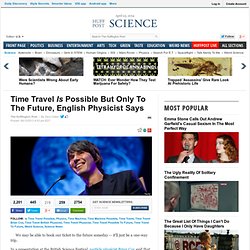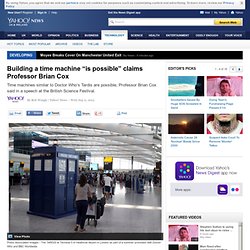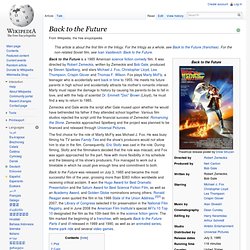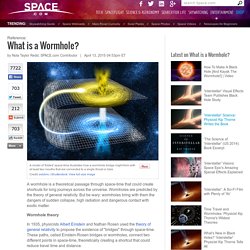

Time Travel Is Possible But Only To The Future, English Physicist Says. We may be able to book our ticket to the future someday -- it'll just be a one-way trip.

In a presentation at the British Science Festival, particle physicist Brian Cox said that time travel is possible but only in one direction. "The central question is, can you build a time machine? The answer is yes, you can go into the future," the University of Manchester professor told the audience during his hour-long speech on Tuesday, according to The Telegraph. "You've got almost total freedom of movement in the future. " Building a time machine “is possible” claims Professor Brian Cox. TV's Professor Brian Cox Time machines similar to Dr Who ’s Tardis are possible, Professor Brian Cox said in a speech at the British Science Festival.

“Can you build a time machine?” Said Professor Cox. Brian Cox: Time Travel is Easy! Kinda. British physics superstar Professor Brian Cox has gone on the record to say that time travel is possible.

Unfortunately, there’s a huge caveat to his claim: if you were able to achieve this feat, you’d only be able to travel into the future never to return. Why? Traveling into the past is impossible. Possibly. Back to the Future. Back to the Future is a 1985 American science fiction comedy film.

It was directed by Robert Zemeckis, written by Zemeckis and Bob Gale, produced by Steven Spielberg, and stars Michael J. Fox, Christopher Lloyd, Lea Thompson, Crispin Glover and Thomas F. Wilson. Fox plays Marty McFly, a teenager who is accidentally sent back in time to 1955. He meets his future parents in high school and accidentally attracts his mother's romantic interest. Zemeckis and Gale wrote the script after Gale mused upon whether he would have befriended his father if they attended school together. The first choice for the role of Marty McFly was Michael J. Plot[edit] While exploring the 1955 Hill Valley, Marty meets the teenage George, who is being bullied by Biff and is secretly writing science fiction stories.
Marty makes several attempts to set George up with Lorraine. Marty arrives at the clock tower, where Doc is making final preparations. Cast[edit] Development[edit] Writing[edit] Casting[edit] Michael J. Turning a Hot Tub into a Time Machine. Last weekend, I watched the comedy Hot Tub Time Machine (starring John Cusack, Rob Corddry, Craig Robinson and Clark Duke).

In a nutshell, I thought it was pretty good. But me being me, I wondered what it would take to actually turn a hot tub into a time machine. So when I got home, I did some calculations (no, I don’t have a social life) and worked out how much power a hot tub would need to become a time machine. Warning: You can leave your physics at the door; the following text is the product of pure science fiction, basic math and an over-active imagination.
What’s it about? The plot of Hot Tub is fairly straight-forward: Three old friends, Adam (Cusack), Lou (Corddry), and Nick (Robinson) take Adam’s geeky nephew Jacob (Duke) on a trip to their old 1980′s holiday spot to relive their teenage years. The focus of the movie is on an empty hot tub (plus decomposing raccoon inside) that Adam and co. find outside their flea-bitten hotel room. But how did that happen? How much energy? Top 5 Time Travel Methods from the Movies. Planet of the Apes (1968) Put briefly, astronaut Taylor (Charlton Heston) unknowingly goes on a journey to a future Earth where apes have guns, don't believe in the possibility of flight, and rule the planet.

Humans are still around in this future, but are mute and quite unintelligent. The best thing about this movie is that they talk about real scientific theories in explaining how they traveled through time. "According to Dr. Hasslein's theory of a vehicle traveling near the speed of light, the earth has aged nearly 700 years since we left it, while we've aged hardly at all," says Taylor in the opening scene of the movie. Actually, it's based more on theories of a man named Albert Einstein. In 1971, the Hafele-Keating experiment proved this with very accurate atomic clocks. "This means, for a space traveler traveling close to the speed of light, that this effect will happen dramatically. Top 5 Sci-Fi Time Travel Methods. 4.

Twin paradox. In physics, the twin paradox is a thought experiment in special relativity involving identical twins, one of whom makes a journey into space in a high-speed rocket and returns home to find that the twin who remained on Earth has aged more.

This result appears puzzling because each twin sees the other twin as traveling, and so, according to an incorrect naive application of time dilation, each should paradoxically find the other to have aged more slowly. However, this scenario can be resolved within the standard framework of special relativity: Acceleration is not relative, unlike position and velocity, and one twin is accelerated more than the other. Therefore the Twin paradox is not a paradox in the sense of a logical contradiction. The twin paradox has been verified experimentally by precise measurements of atomic clocks flown in aircraft and satellites.
For example, gravitational time dilation and special relativity together have been used to explain the Hafele–Keating experiment. Grandfather paradox. Time Travel? Don't Forget to Pack Your Wormhole. The concept of a time machine typically conjures up images of an implausible plot device used in a few too many science-fiction storylines.

Facts, Theory & Definition of Wormholes. A wormhole is a theoretical passage through space-time that could create shortcuts for long journeys across the universe.

Wormholes are predicted by the theory of general relativity. But be wary: wormholes bring with them the dangers of sudden collapse, high radiation and dangerous contact with exotic matter. Wormhole theory In 1935, physicists Albert Einstein and Nathan Rosen used the theory of general relativity to propose the existence of "bridges" through space-time. Wormhole Time 'Machine' Called Best Bet For Back-In-Time Travel. The concept of a time machine typically conjures up images of an implausible plot device used in a few too many science-fiction storylines. But according to Albert Einstein's general theory of relativity, which explains how gravity operates in the universe, real-life time travel isn't just a vague fantasy. Traveling forward in time is an uncontroversial possibility, according to Einstein's theory. In fact, physicists have been able to send tiny particles called muons, which are similar to electrons, forward in time by manipulating the gravity around them.